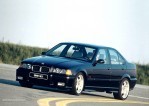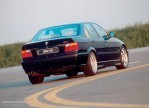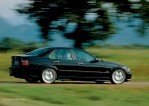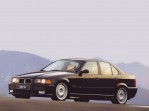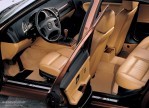Segment: Lower Premium
Production years: 1994, 1995, 1996, 1997, 1998
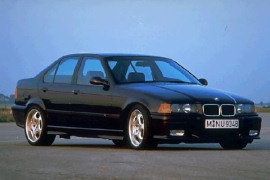 23 Photos
23 PhotosBMW introduced the second generation of the M3 in 1992 as a coupe, and two years later, it unveiled the four-door version for it.
While the E30 M3 was available only as a coupe, the second generation was available with a four-door sedan and a convertible bodywork. Thus, those who needed a four-door vehicle that was fun to drive and sporty had the option to get one from the German automaker.
Unlike its predecessor, the second generation of the M3 was more subtle. It took someone with a keen eye for detail to distinguish an M-version from a regular one. But there were a few details that revealed the differences. For starters, the front bumper was different. Unlike its regular sibling, the M3 sedan featured an apron that sported a rectangular air intake in the middle, flanked on the sides by two small scoops and squared fog lamps. On the profile, the door mirrors were aerodynamically profiled and mounted on the bodywork with two thinner supports instead of a single, wider one. Moreover, the rocker panels were sculptured so they could divert the air from the sides and prevent it from entering under the car. Finally, at the back, the M3 sedan received a diffuser under the bumper and a wing on the trunk.
Inside, the automaker installed a three-spoke steering wheel with a small M-badge on the lower one. All versions got high-bolstered bucket seats at the front with multiple adjustments. As an option, BMW offered leather upholstery. Also standard was a high-fi sound system and an onboard computer. Worth noticing that the red line on the tachometer started at 7,500 rpm.
Under the hood, the car was introduced with a 3.0-liter inline-six engine that developed 286 PS for the European market but just 240 for the U.S. customers. In 1995, the German automaker upgraded the powerplant to a 3.2-liter displacement that led to 321 PS for European customers but the same 240 ponies for the U.S. market.
BMW M3 Sedan (E36) 1994, 1995, 1996, 1997, 1998
- 3.0L 5MT RWD (286 HP)
- 3.2L 5MT RWD (321 HP)
BMW M3 Sedan (E36)
3.0L 5MT RWD (286 HP)
ENGINE SPECS - 3.0L 5MT RWD (286 HP) | |
|---|---|
| Cylinders: | L6 |
| Displacement: | 2990 cm3 |
| Power: | 210 KW @ 7000 RPM 286 HP @ 7000 RPM 282 BHP @ 7000 RPM |
| Torque: | 236 lb-ft @ 3600 RPM 320 Nm @ 3600 RPM |
| Fuel System: | Multipoint Injection |
| Fuel: | Gasoline |
PERFORMANCE SPECS | |
|---|---|
| Top Speed: | 155.3 mph (250 km/h) |
| Acceleration 0-62 Mph (0-100 kph): | 6 s |
TRANSMISSION SPECS | |
|---|---|
| Drive Type: | Rear Wheel Drive |
| Gearbox: | 5-Speed manual |
BRAKES SPECS | |
|---|---|
| Front: | Ventilated Discs |
| Rear: | Ventilated Discs |
TIRES SPECS | |
|---|---|
| Tire Size: | 225/45 R17 (Front) - 245/40 R17 (Rear) |
DIMENSIONS | |
|---|---|
| Length: | 174.4 in (4430 mm) |
| Width: | 67.3 in (1709 mm) |
| Height: | 53.5 in (1359 mm) |
| Front/rear Track: | 55.9/56.7 in (1,420/1,440 mm) |
| Wheelbase: | 106.7 in (2710 mm) |
| Ground Clearance: | 4.3 in (109 mm) |
| Cargo Volume: | 15.4 cuFT (436 L) |
WEIGHT SPECS | |
|---|---|
| Unladen Weight: | 3218.7 lbs (1460 kg) |
| Gross Weight Limit: | 4299 lbs (1950 kg) |
FUEL ECONOMY (NEDC) | |
|---|---|
| Combined: | 25.8 mpg US (9.1 L/100Km) |
| CO2 Emissions: | 217 g/km |
BMW M3 Sedan (E36)
3.2L 5MT RWD (321 HP)
ENGINE SPECS - 3.2L 5MT RWD (321 HP) | |
|---|---|
| Cylinders: | L6 |
| Displacement: | 3201 cm3 |
| Power: | 236 KW @ 7400 RPM 321 HP @ 7400 RPM 316 BHP @ 7400 RPM |
| Torque: | 258 lb-ft @ 3250 RPM 350 Nm @ 3250 RPM |
| Fuel System: | Multipoint Injection |
| Fuel: | Gasoline |
PERFORMANCE SPECS | |
|---|---|
| Top Speed: | 155.3 mph (250 km/h) |
| Acceleration 0-62 Mph (0-100 kph): | 5.5 s |
TRANSMISSION SPECS | |
|---|---|
| Drive Type: | Rear Wheel Drive |
| Gearbox: | 5-Speed manual |
BRAKES SPECS | |
|---|---|
| Front: | Ventilated Discs |
| Rear: | Ventilated Discs |
TIRES SPECS | |
|---|---|
| Tire Size: | 225/45 R17 (Front) - 245/40 R17 (Rear) |
DIMENSIONS | |
|---|---|
| Length: | 174.4 in (4430 mm) |
| Width: | 67.3 in (1709 mm) |
| Height: | 53.5 in (1359 mm) |
| Front/rear Track: | 55.9/56.7 in (1,420/1,440 mm) |
| Wheelbase: | 106.7 in (2710 mm) |
| Ground Clearance: | 4.3 in (109 mm) |
| Cargo Volume: | 15.4 cuFT (436 L) |
WEIGHT SPECS | |
|---|---|
| Unladen Weight: | 3218.7 lbs (1460 kg) |
| Gross Weight Limit: | 4299 lbs (1950 kg) |
FUEL ECONOMY (NEDC) | |
|---|---|
| City: | 13.9 mpg US (16.9 L/100Km) |
| Highway: | 31.3 mpg US (7.5 L/100Km) |
| Combined: | 21.3 mpg US (11 L/100Km) |
| CO2 Emissions: | 263 g/km |
